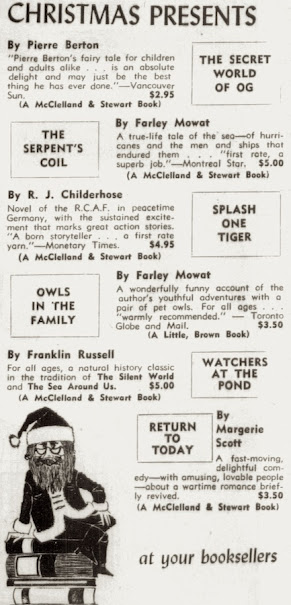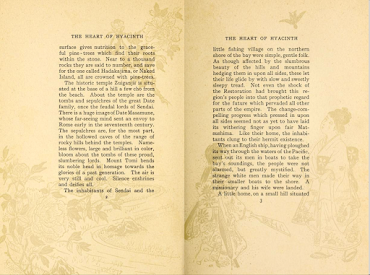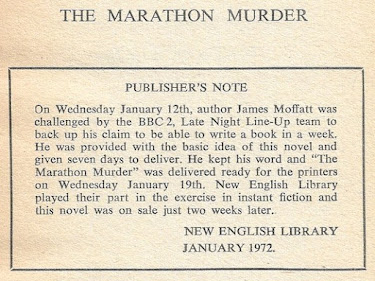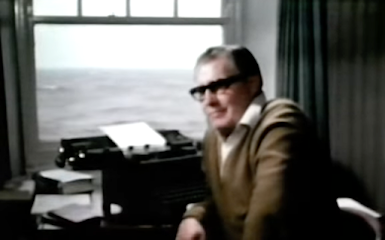Quietly My Captain Waits
Evelyn Eaton
New York: Grosset & Dunlap, [c. 1943]
355 pages
I first learned of Louise de Freneuse last autumn during a visit to Nova Scotia. A historic plaque outlining her life served as my introduction. Something I came upon during an early evening stroll through Annapolis Royal, the story it told beggared belief.
Her entry in the Dictionary of Canadian Biography will explain my reaction.
There is little wonder that Louise de Freneuse inspired a historical novel. This description of the lady comes from original publisher Harper & Bros:
As courageous as she was captivating, she defied every convention and all the wilderness in a gallant fight for love and happiness.
 |
| New York Times, 8 September 1940 |
Quietly My Captain Waits was a critical and commercial success; comparisons were drawn to Gone With the Wind and Hollywood came calling:
 |
| Boxoffice Barometer, 22 February 1941 |
Here I note that Evelyn Eaton's novel is set well before the "French and Indian Wars [sic]" and the capture of Quebec. It's likely that Louise de Freneuse's death pre-dates the Battle of the Plains of Abraham by more than four decades.
Quietly My Captain Waits begins on an early evening in 1691 with young Raoul de Perrichet's return to his family home in the French commune of Draguigan. Not twenty-four hours earlier, he'd caught serial adulterer Vanina in the arms of the Compte de Callian, "old enough to be her father and Raoul's grandfather, Bigre!" Sixteen-year-old Raoul had wanted her for himself – he'd enjoyed Vanina's delights in the past – and in anger and frustration molests petite Marie "who had always loved him."
Raoul now finds himself under threat of imprisonment; not for the molestation, you understand, rather for what he witnessed in Vanina’s bedchamber. The Comte, who has the King’s ear, cannot entrust his reputation to a boy’s discretion. Raoul finds a saviour in his dashing uncle, Pierre de Bonaventure, captain of the Soleil d’Afrique – “the fastest vessel in the world!” – who enlists his nephew in the navy and sets sail for New France.
 |
| Armed Services Edition, 1945 |
Raoul doesn’t prove much of a seaman, but de Bonaventure is happy to have him aboard for games of bezique and to share the occasional bottle. One drunken evening, l’Oncle Pierre tells a tale about a raven-haired beauty. All occurred seven years earlier in New France; she was the sixteen-year-old daughter of an important man while de Bonaventure was then a twenty-six-year-old nothing. When the important man learned of the relationship, he sent the girl to a convent. She escaped, cut her hair, dressed as a boy, and made for her lover’s ship as it was about to set sail for France. Her idea was that they could marry in the Old World, but de Bonaventure turned her away.
In Quebec City, Raoul meets the raven-haired beauty, and falls in love with her himself. This is, of course, Louise de Freneuse, the girl his uncle loved – and still loves – who is now a twice-married woman with children. De Bonaventure does all he can not to avoid her, but fails. When the Soleil d’Afrique is tasked with transporting the Madam de Freneuse to her second husband’s Acadian home, the two old flames come together and things become very hot.
De Bonaventure is so ignorant of his Raoul’s love for Louise that he hands over the nephew who is so ill-suited to life at sea. Raoul arrives at the settlement built by Louise’s husband, Mathieu de Freneuse, and is tasked with tutoring her children.
Mathieu de Freneuse is a force to be reckoned with, matrimonial bedroom excepted. His passion for Louise is equal to de Bonaventure’s, but the poor man has long recognised that her own passion lies in the memory of an old love (see: Simon-Pierre Denys de Bonaventure). A Frenchman who has come to be accepted as a member of the local “Micmacs,” Mathieu finds sexual outlet amongst the tribe’s women. He encourages the teenaged tutor to undergo the same initiation he endured, and then enjoy the same benefits.
This Raoul does, but only to prove his love for Louise.
It’s complicated.
Remarkably – improbably – Raoul grows to become a great Micmac leader, but not before Mathieu de Freneuse and his settlement are destroyed by Iroquois warriors. Mathieu expires in the arms of the miller’s daughter, with whom, it turns out, he’d been having an affair.
 |
| New York: Permabooks, 1951 |
Quietly, the reader turns eighty pages, awaiting Captain de Bonaventure's return.
In her Author’s Note, Evelyn Eaton writes of the research she put into writing Quietly My Captain Waits.
Let us consider the nameless miller's daughter, who enters and exits the novel during Mathieu de Freneuse's final minutes. Gervais Tibault's existence spans not more pages. In the author's fiction, he is a favoured child, the first-born of her first marriage. A sensitive soul, better suited for the salons of Paris than the backwoods of Acadia, Gervais Tibault is killed by Iroquois arrows. Eaton places characters she created – those not based on historical figures – as if they are all of equal weight, and yet the actions of the fictitious Raoul de Perrichet are far more consequential than those of Louise and Pierre.
Eaton uses the “fragments” fro which she wove her novel to good effect, but she does not tie them to fact. It is true that, Louise did in fact cross the Bay of Fundy in open canoe in winter, but it was not to meet de Bonaventure in a remote inlet, as in the novel. In reality – sans conjecture – Louise made for English-occupied Annapolis Royal. At the time, de Bonaventure was dead and buried in France.
At its heart, Quietly My Captain Waits is a love story inspired by scandale. Louise's very public relationship with the married de Bonaventure produced a son. We have avocat Mathieu de Goutins to thank for documenting their relationship. A pathetic figure in Eaton’s novel, he sent several letters to Paris complaining of the lovers’ conduct. De Goutins' puritanical outrage was shared twenty-three decades later by an anonymous reviewer in St Petersburg Times (30 June 1940):
You will soon be hearing a great deal about this book but take this reviewer’s advice if you are thinking of buying or renting it – save your money. Wait until you can see the movie version of it that will have to be censored.
It is said that Hollywood paid $40,000 for it before it appeared in print – only a paltry $10,000 less than was paid for “Gone With the Wind.” It is a type of book that is this reviewers particular bete noir.
We review few novels for the present trend is toward a particularly disgusting realism that seems to be increasing.
René Baudry, who wrote Louise de Freneuse's entry in the Dictionary of Canadian Biography, had other issues. He makes no mention of Quietly My Captain Waits by title, rather concludes with a veiled reference:
An American novelist has written a questionable novel about Mme de Freneuse. What need is there of adding imaginary episodes to the ardent and courageous life of this woman, the heroine of a true romance filled with adventure and passion?
The late M Baudry is mistaken. Evelyn Eaton was not an American novelist, although she did take out citizenship in her forties. Eaton was born in 1902 to Canadian parents in Montreux, Switzerland, and lived much of her early life in New Brunswick. After the death of her father at Vimy Ridge, the family moved to England. She studied at Heathfield School and the Sorbonne. While at the latter, Eaton became pregnant and gave birth to a daughter, Therese, whom she raised. Eaton married a Polish count, fled the Nazis, made her way to the United States, and wrote for the New Yorker. She published more than thirty books, encompassing novels, poetry, non-fiction, and biography. Her name doesn’t feature the Canadian Encyclopedia, The Oxford Companion to Canadian Literature, or the Encyclopedia of Canadian Literature, but she does have a highly informative entry at the Canada’s Early Women Writers.
Returning to René Baudry's comment, I remind that Quietly My Captain Waits is a historical novel.
Historical novels are works of fiction.
Works of fiction feature imaginary episodes.
Quietly My Captain Waits is a hell of a story.
Hollywood could not have done better.
At first he thought the ship was sinking, and that the two snoring men with whom he had gone to bed had left him there to die.
Trivia: Hollywood has yet to adapt of the novel. Consensus is that another war intruded. Eaton used money from the sale to build a summer home on the Bay of Fundy.
Object: For the life of me, I cannot remember when and where I bought this book. What I can say for certain is that I paid no more than a dollar. I may have paid nothing. It once belonged to Cicely and Scottie Mitchell, a couple who lived at 12 Elmwood Avenue, Senneville, Quebec. If the notation on the frontispiece is accurate, it was added to their library on 18 March 1943. I found this postcard within its pages.
I'm happy to report that the Mitchells' house still stands. It's quite beautiful.
Access: The novel was first published in 1940 by Harper (New York) and Cassell (London). The Grosset & Dunlop followed a Literary Guild of America edition. In 1945, American GIs were treated to an Armed Services edition. In 1951, Permabooks' published the second paperback edition. Fifteen years later, Pyramid published a the first of its two mass market paperback editions.
The novel is currently in print from Formac as one of its Fiction Treasures titles. First editions, Armed Services copies, and vintage paperbacks are always tempting, but I recommend the Formac for its introduction by Barry M. Moody. It can be purchased through this link.
Surprisingly, there is no French translation, though there is a Portuguese:
Até um dia, meu capitão!
Quietly My Captain Waits was read for
the 1940 Club.


















































